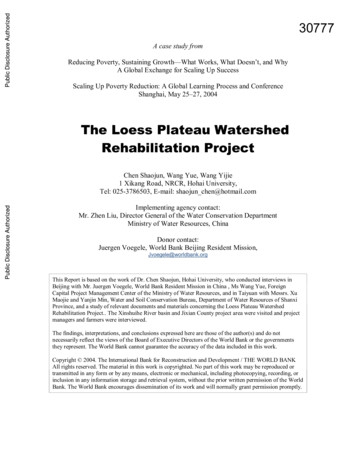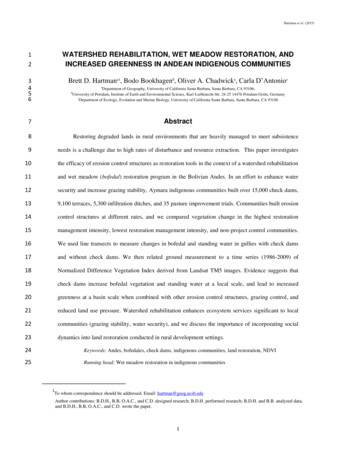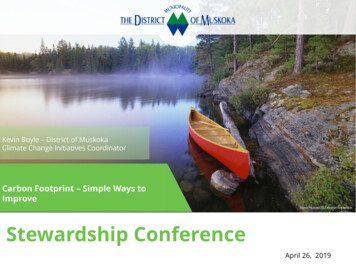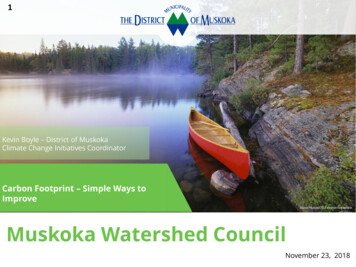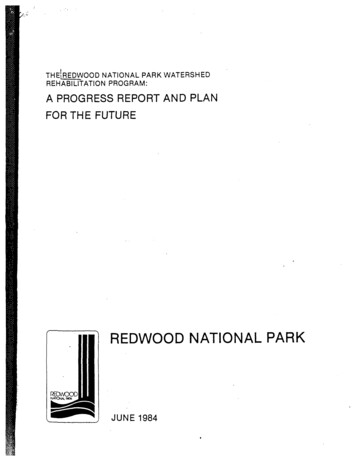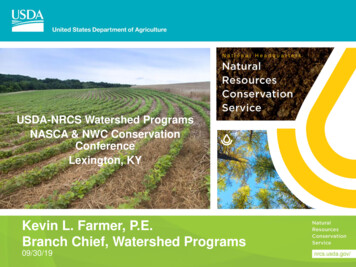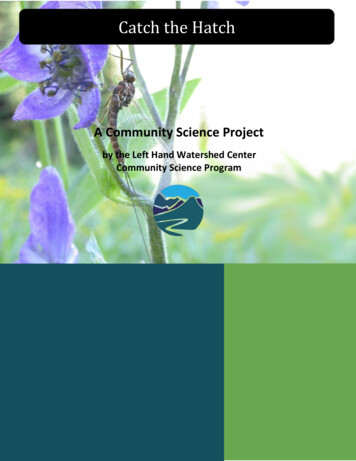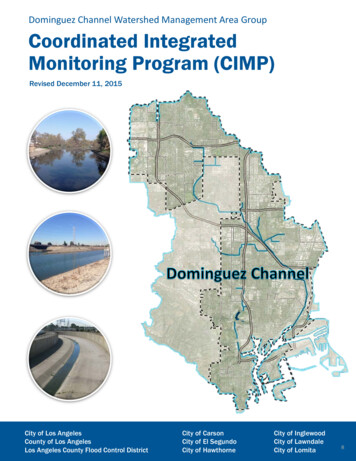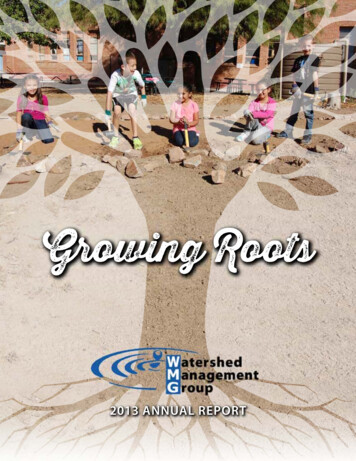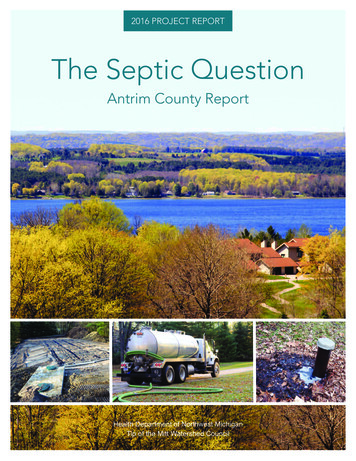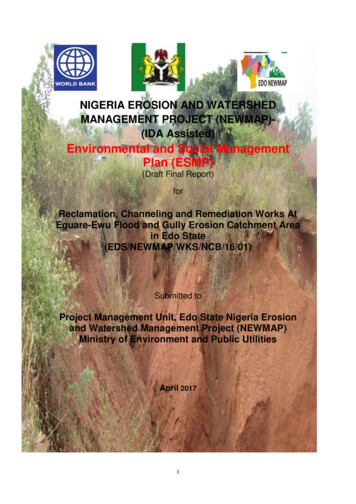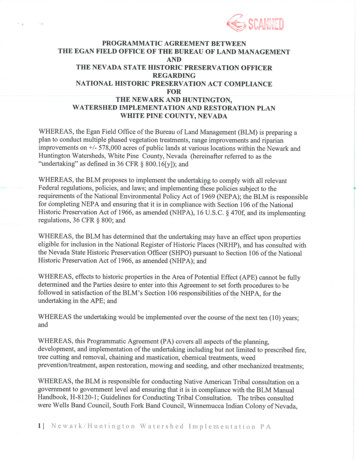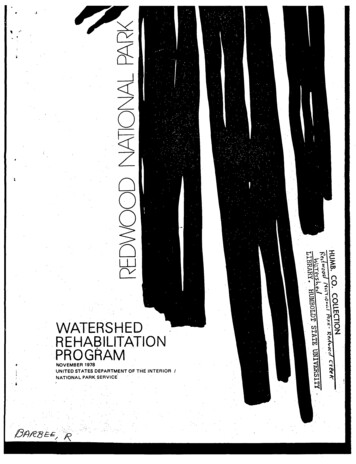
Transcription
.,,j/'WATERSHED.REHABILITATIONPROGRAM . .NOVEMBER 1978UNITED STATES DEPARTMENT OF THE INTERIOR INATIONAL PARK SERVICE
,United States Department of the InteriorNATIONAL PARK SERVICEII'f REPLY REPER TO:REDWOOD NATIONAL PARKDRAWERN - 1111 SECOND STREETCRESCENT CITY, CALIFORNIA 95531November 1978Dear Friend:Many of you indicated an interest in receiving lOOre information aboutthe rehabilitation program for Redwood National Park.The enclosednewsletter provides a background to the effort, explains where we arenow in the rehabilitation of the Redwood Creek watershed, and outlineswhat we intend to do OVer the next few years to carry out the rehabi1ita tien program.Thanks again for your interest in Redwood National Park.Sincerely yours, Robert D. BarbeeSuperintendentEnclosure.'
\WATERSHED REHABILITATION PROGRAMINTRODUCTIONThe creation and later expansion of Redwood National Park resulted in theacquisition of approximately 48,000 acres of cutover timberlands. Theselands, representing nearly 45% of the 106,000-acre national park, wereintensively modified by logging activities, including the construction ofapproximately 300 miles of truck roads and 3,500 miles of tractor trails.Besides directly altering the landscape and causing soil compaction, loss oftopsoil, destruction of ground cover, elimination of shade, and' massivechanges to small drainages, the logging activities also produced cumulativedownstream impacts. These include increased streamside landslides, elevatedand wider streambeds, greater bank erosion, higher winter stream discharge,and lower summer discharge. These physical changes of the stream systemhave been accompanied by modification of aquatic biota and streamsidevegetation.The problems associated with cutover lands were addressed directly in thelegislation which expanded the park. Section 101 (a){6) of Public Law95-250, March 27, 1978, authorized "the development and implementationof a program for the rehabilitation of areas within and upstream from thePark contributing significant sedimentation because of past loggingdisturbances and road conditions and, to the extent feasible, to reduce riskof damage to streamside areas adjacent to Redwood Creek." Section 105 ofthe public Jaw authorized 33 million to be appropriated as of October 1,1978, to carry out the rehabilitation provisions of the act.GOALS AND OBJECTIVESAs a result of this legislative mandate, a number of goals and objectives havebeen established for the rehabilitation program. The long-term goal is toreturn the downstream portion of the Redwood Creek drainage basin that iswithin the national park to a reasonable facsimile of its natural state, keepingin mind that some man-induced erosion from upstream land practices willcontinue. The immediate goal' is to minimize continuing and futureman-induced inputs of sediment to the Redwood Creek stream system andto manage the existing stream sediment load to reduce its impact on theresources of Redwood National Park.3
There are three objectives in meeting the immediate goal of therehabilitation program. The first is to minimize man-induced erosion in thenational park while encouraging the return of a natural pattern of vegetation.The second objective is to minimize man-induced erosion and to stabilizenatural erosional processes upstream from the national park within the parkprotection zone, while still fostering the productivity of commercialforestland in the protection zone. The third objective is to enhance localemployment, in keeping with the provisions of section 103 of P L 95-250.1978 PROJECTSThe first steps to meet these goals and objectives are to find out themagnitude of the problem and to determine the best rehabilitation methodsto apply in the watershed. One key difficulty is the lack of knowledge aboutrehabi litation techniques that are applicable to the steep, unstable conditionsfound in the Redwood Creek watershed. Although four previous testprojects have provided some information regarding methods, there is still arelative lack of data on the subject.To gain a better understanding of the problem and to develop possiblesolutions, the Redwood National Park staff held a workshop inMarch 1978regarding "Techniques of Rehabilitation and Erosion Control in RecentlyLogged Watersheds." The workshop brought together many professionalswho are working in rehabilitation and erosion control from throughout.California and Oregon. During this past summer, aerial photographs of the. lower basin were obtained to help set priorities for rehabilitating areas wheresediment-yield problems are most critical. In addition, an onsite survey ofroads within the basin has been undertaken to determine ongoingmaintenance needs and to make preliminary judgments about the viability ofcertain roads.To test and evaluate rehabilitation techniques, the National Park Service hasbegun five projects in the Redwood Creek watershed: upper Miller Creek (80acres), lower Weir Creek (80 acres), upper Bond Creek (85 acres), lowerBond Creek (7 acres), and on a landing along the C-line road (see map). Theprojects are designed to control further erosion by attempting to reestablishnatural drainage patterns on tractor-yarded c1earcuts, by removing streamcrossings and culverts that are failing, by reshaping road surfaces, and byplanting exposed soil surfaces to control surface erosion. Planting willinclude spreading grass seed to assure a rapid recovery of ground cover and4
v-------Ht?J:J\\t,.;-: ----- rc.f'OIe.lI---- S1ffil PNa"lIl'------ ----H:?M.flP HIll. PO'O. e6'C.H---./e:I;'Qi-----'C)(\TTl»z PO'P'-------- F9 l"ll --------- ,C CWewFf- i-------- '-----.:.:.-::.--- THINNING PLOTREHABILITATION TEST SITES-'"""'-"""JllIIllI """"" """"' 101!- 1No.1lt REDWOOD CREEK-WATERSHED REHABILITATIONREDWOOO NATIONAL PARKU"IT1Dn"ns Dl "'fIITMINT Of T"
,\.utilizing willow cuttings bundled into wattles, which will sprout in thespring. Native conifer tree species will also be planted to assure thereestablishment of native forests. Brush thinning for tree release will be doneas needed.The test sites were chosen because they are representative of logged-overportions of the watershed. In each area, existing conditions were thoroughlydocumented prior to rehabilitation efforts; once the rehabilitation work iscomplete, the results will again be recorded. Each site will be carefullymonitored throughout this winter and next summer to ensure that the workhas been effective. The evaluation of this year's test projects will providevital information in determining programs for succeeding years. The majorityof the work is being accomplished under contract with the National ParkService and is being supervised by the Natural Resources Division staff at thepark. OTHER PROGRAMSLand rehabilitation is only one part of the effort to restore the park to nearpre-logging conditions. Thinning dense stands of young, second-growth treeswill also be undertaken to return the stands to a more natural composition,similar to what existed prior to logging and reforestation. The thinning willstimulate growth of the remaining trees, reduce fuel loads for wildfires, andeliminate exotic species. This summer and fall, approximately 220 acres ofnational parkland on the west side of Holter Ridge (see map) have beenthinned by locally hired park crews and contractors.The National Park Service staff is continuing to monitor timber harvesting inthe park protection zone by reviewing timber harvest plans with therespective timber companies. The reviews are in accordance with section101(a)(2)(c) of PL 95-250 and are intended to ensure that harvestingpractices do not result in physical damage to park resources downstream.Although the most attention to date has been focused on protecting theforests within the park, ways to control gullying in the prairies will also beinvestigated by the park staff. The prairie soils tend to erode easily whentheir grass cover is removed and they are subjected to concentrated runofffrom winter storms. The problem is most pronounced along the Bald Hillsroad.7
.FUTURE REHABILITATIONThe rehabilitation program will be expanded greatly in succeeding years, asmore knowledge of rehabilitation techniques is gained through evaluation ofthis year's program. A variety of techniques will have to be tried atappropriate sites, followed by long-term monitoring, before the fu IIrehabilitation program can be implemented. It is expected that annualrevisions will occur and that future actions will be based on the successes orfailures of actions taken during previous years.As the nation's principal conservation agency, the Department of theInterior has basic responsibilities to protect and conserve our land and water,energy and minerals, fish and wildlife, parks and recreation areas, and toensure the wise use of all these resources. The department also has majorresponsibility for American Indian reservation communities and for peoplewho live in island territories under U.S. administration.Publication services were provided by the graphics and editorial staffs of theDenver Service Center. NPS 13578
the rehabilitation program for Redwood National Park. The enclosed newsletter provides a background to the effort, explains where we are now in the rehabilitation of the Redwood Creek watershed, and outlines what we intend to do OVer the next few years to carry out the rehabi1i-tatien program. Thanks again for your interest in Redwood National .
